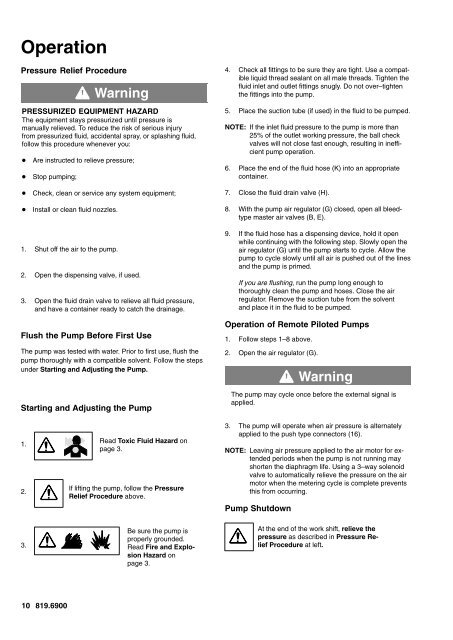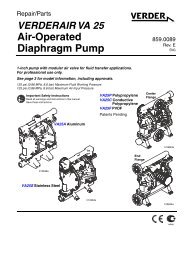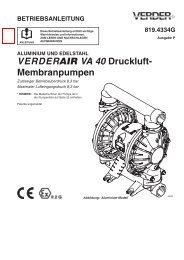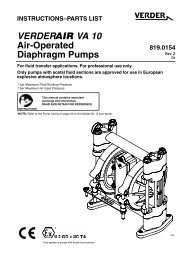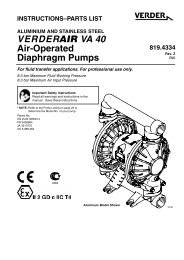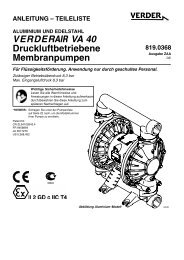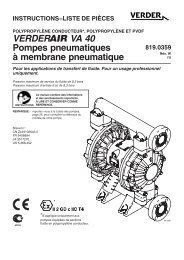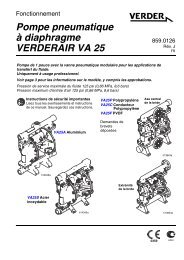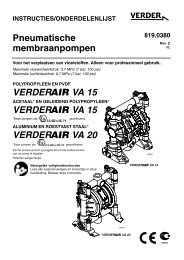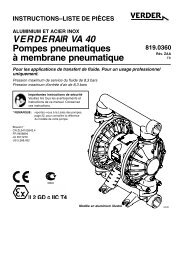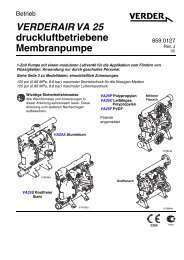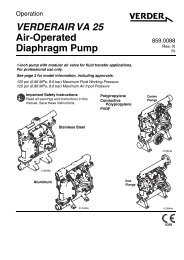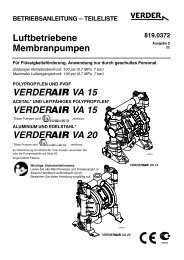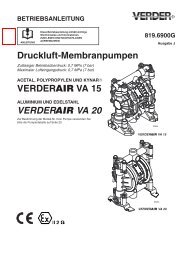Air-Operated Diaphragm Pumps VERDER VA 15 VERDER VA 15 VERDER VA 20
verderair va 20 - Double Diaphragm Pump
verderair va 20 - Double Diaphragm Pump
Create successful ePaper yourself
Turn your PDF publications into a flip-book with our unique Google optimized e-Paper software.
Operation<br />
Pressure Relief Procedure<br />
Warning<br />
PRESSURIZED EQUIPMENT HAZARD<br />
The equipment stays pressurized until pressure is<br />
manually relieved. To reduce the risk of serious injury<br />
from pressurized fluid, accidental spray, or splashing fluid,<br />
follow this procedure whenever you:<br />
<br />
<br />
Are instructed to relieve pressure;<br />
Stop pumping;<br />
4. Check all fittings to be sure they are tight. Use a compatible<br />
liquid thread sealant on all male threads. Tighten the<br />
fluid inlet and outlet fittings snugly. Do not over–tighten<br />
the fittings into the pump.<br />
5. Place the suction tube (if used) in the fluid to be pumped.<br />
NOTE: If the inlet fluid pressure to the pump is more than<br />
25% of the outlet working pressure, the ball check<br />
valves will not close fast enough, resulting in inefficient<br />
pump operation.<br />
6. Place the end of the fluid hose (K) into an appropriate<br />
container.<br />
<br />
<br />
Check, clean or service any system equipment;<br />
Install or clean fluid nozzles.<br />
7. Close the fluid drain valve (H).<br />
8. With the pump air regulator (G) closed, open all bleedtype<br />
master air valves (B, E).<br />
1. Shut off the air to the pump.<br />
2. Open the dispensing valve, if used.<br />
3. Open the fluid drain valve to relieve all fluid pressure,<br />
and have a container ready to catch the drainage.<br />
Flush the Pump Before First Use<br />
The pump was tested with water. Prior to first use, flush the<br />
pump thoroughly with a compatible solvent. Follow the steps<br />
under Starting and Adjusting the Pump.<br />
Starting and Adjusting the Pump<br />
9. If the fluid hose has a dispensing device, hold it open<br />
while continuing with the following step. Slowly open the<br />
air regulator (G) until the pump starts to cycle. Allow the<br />
pump to cycle slowly until all air is pushed out of the lines<br />
and the pump is primed.<br />
If you are flushing, run the pump long enough to<br />
thoroughly clean the pump and hoses. Close the air<br />
regulator. Remove the suction tube from the solvent<br />
and place it in the fluid to be pumped.<br />
Operation of Remote Piloted <strong>Pumps</strong><br />
1. Follow steps 1–8 above.<br />
2. Open the air regulator (G).<br />
Warning<br />
The pump may cycle once before the external signal is<br />
applied.<br />
1.<br />
2.<br />
Read Toxic Fluid Hazard on<br />
page 3.<br />
If lifting the pump, follow the Pressure<br />
Relief Procedure above.<br />
3. The pump will operate when air pressure is alternately<br />
applied to the push type connectors (16).<br />
NOTE: Leaving air pressure applied to the air motor for extended<br />
periods when the pump is not running may<br />
shorten the diaphragm life. Using a 3–way solenoid<br />
valve to automatically relieve the pressure on the air<br />
motor when the metering cycle is complete prevents<br />
this from occurring.<br />
Pump Shutdown<br />
3.<br />
Be sure the pump is<br />
properly grounded.<br />
Read Fire and Explosion<br />
Hazard on<br />
page 3.<br />
At the end of the work shift, relieve the<br />
pressure as described in Pressure Relief<br />
Procedure at left.<br />
10 819.6900


